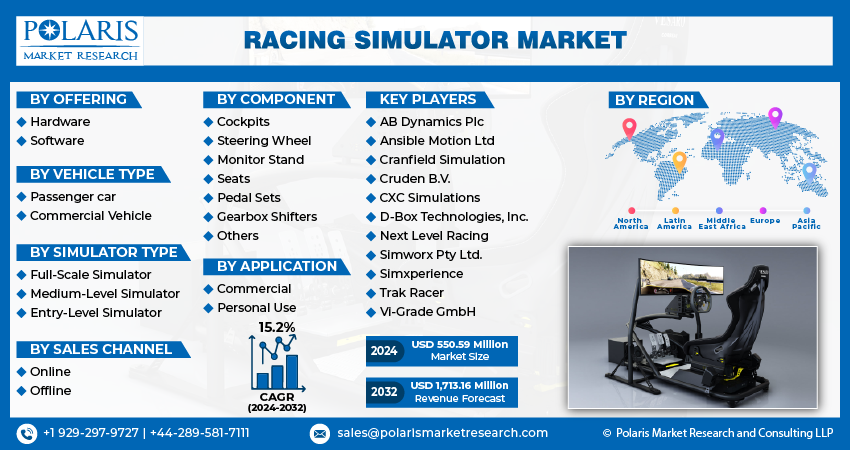
Racing Simulator Market Share, Size, Trends, Industry Analysis Report
By Offering (Hardware, Software); By Vehicle Type; By Simulator Type; By Component; By Sales Channel; By Application; By Region; Segment Forecast, 2024 - 2032
- Published Date:Mar-2024
- Pages: 118
- Format: PDF
- Report ID: PM4707
- Base Year: 2023
- Historical Data: 2019-2022
Report Outlook
Global racing simulator market size was valued at USD 479.06 million in 2023. The market is anticipated to grow from USD 550.59 million in 2024 to USD 1,713.16 million by 2032, exhibiting a CAGR of 15.2% during the forecast period
Racing Simulator Market Overview
The key factors significantly propel the expansion of the racing simulator market. One major driver is the increasing popularity of e-sports tournaments and leagues, where racing simulators market development plays a crucial role in providing a realistic and competitive platform for virtual racing. Additionally, there is a growing interest in professional motor racing events, with many enthusiasts turning to racing simulators to experience the thrill and challenges of real racing tracks.
- For instance, in November 2023, D-BOX Technologies Inc. and Playseat have partnered to integrate D-BOX's haptic technology into Playseat's sim racing chassis and flying simulation cockpits, enhancing the immersive experience for users worldwide.

To Understand More About this Research: Request a Free Sample Report
Continuous advancements in simulation technology are also contributing to the market's growth. Manufacturers are constantly improving their simulators, enhancing features such as graphics, physics engines, and force feedback systems to deliver a more immersive and realistic experience for users. This, coupled with the increasing affordability of racing simulators, is making them more accessible to a wider audience.
Furthermore, there is a growing focus on using racing simulator market players for professional training purposes, especially in the motorsports industry. These simulators allow drivers to practice and refine their skills in a safe and controlled environment, helping them prepare for real-life racing events. Similarly, racing simulators are increasingly being used for recreational gaming, with many users enjoying the thrill of virtual racing from the comfort of their homes.

Racing Simulator Market Dynamics
Market Drivers
The increasing quantity of eSports events offering large cash prizes drives the racing simulator market growth
The rise of esports has led to a surge in demand for racing simulators, offering gamers an immersive experience without the high costs of real-world racing. These simulators provide accessible and affordable competition, requiring only a gaming PC and simulator setup. Enhanced internet speeds facilitate the incorporation of high-definition graphics, intricate track simulations, and seamless integration with virtual reality technology. Major esports events such as the Formula One Esports Series showcase sim racing talent and draw enthusiasts with lucrative prize pools, driving further demand for racing simulator market growth. For instance, the Formula One Sim Racing World Championship hosted a virtual sim racing competition with a prize pool of USD 750,000. This increasing trend of esports events will motivate participants of all ages to join and compete, leading to a surge in demand for racing simulators worldwide.
Market Restraints
The high cost of accessories and their integration are likely to impede the racing simulator market growth.
The high cost associated with racing simulators presents a major challenge to the racing simulator market growth and accessibility. These simulators require advanced hardware and software to deliver an authentic experience, leading to expensive development and manufacturing costs. As a result, the retail price of simulators is steep, limiting their adoption to a niche audience with the financial means to afford them. This high cost may deter casual gamers or those with a passing interest in racing simulations, hindering the industry's expansion.
Furthermore, the need for gaming peripherals such as high-performance GPUs, processors, and other accessories adds to the overall expense of the simulator. As a result, the demand for mid-level and full-scale, motion-based simulators is constrained, mainly used in commercial and professional training contexts. In economically sensitive regions like China, India, and Brazil, the uptake of advanced and full-scale racing simulators is primarily among individuals with significant disposable incomes. Moreover, the high cost may dissuade businesses and gaming venues from incorporating racing simulators into their establishments, limiting the industry's overall market penetration.
Report Segmentation
The market is primarily segmented based on offering, vehicle type, simulator type, component, sales channel, application, and region.
|
By Offering |
By Vehicle Type |
By Simulator Type |
By Component |
By Sales Channel |
By Application |
By Region |
|
|
|
|
|
|
|
To Understand the Scope of this Report: Speak to Analyst
Racing Simulator Market Segmental Analysis
By Vehicle Type Analysis
- The passenger cars segment leads the market of racing simulators owing to the growing number of vehicle racing events, championships, and virtual competitions of passenger cars booming the racing simulators market opportunity. Particularly well-liked events include Formula 1, NASCAR, the Indycar Series, the Canada Grand Prix, the Nascar All-Star Open, and the GMR Grand Prix. In the virtual racing world, these events are all the more appealing because passenger car models are featured extensively in many of them. For instance, the Formula 1 series draws spectators from all around the world with its high-performance vehicles, which resemble modified passenger automobiles.
Users can enjoy an amazing virtual driving experience with models like McLaren Automotive, Ferrari, Porsche, and BMW. Along with having many professional racing leagues and a long history in motorsports, car racing also has a large and dedicated fan base throughout the world. Passenger vehicles are expected to continue to hold a significant position in the racing simulator industry due to their broad popularity, inclusion in important events, developments in simulator technologies such as artificial intelligence and virtual reality, and the ongoing expansion of virtual racing tournaments.
By Application Analysis
- Based on application analysis, the market has been segmented on the basis of commercial and personal use. The commercial segment is expected to grow at the fastest CAGR during the racing simulator market forecast period. Commercial racing simulators are made for usage in a range of professional settings, such as theme parks, bars, and restaurants featuring sports, esports competitions, gaming lounges, simulator arcades, and racing training centers. High-end parts like realistic pedal sets, force-feedback steering wheels, and sophisticated motion platforms are commonly included in these systems. These simulators are used for training and vehicle development by professional teams, drivers, and training facilities. Racing teams from well-known automakers, including Porsche, Mercedes-Benz, Ford, Ferrari, and others, employ these vehicles to improve their performance.

Racing Simulator Market Regional Insights
The North American region dominated the global market with the largest racing simulator market share in 2023
The North American region dominated the global market with the largest racing simulator market share in 2023 and is expected to maintain its dominance over the racing simulator market forecast period. The market is primarily led by the US and Canada, known for their rich car racing heritage and active virtual racing scene. Popular events in this region include the 24 Hours of Daytona, US Grand Prix (Formula 1), World Rally Championships, Canadian Grand Prix (Formula 1), NASCAR Cup Series, Grand Prix de Trois-Rivières, Indianapolis 500 (IndyCar). These events appeal to a wide range of enthusiasts spanning different age groups. The high-speed action, combined with advanced technologies and vibrant atmospheres, creates an exhilarating experience that users seek to replicate with racing simulators. These simulators provide an interactive and realistic platform for enthusiasts to engage with the sport, offering a compelling alternative. As a result, there is a growing demand for compact simulators in these countries, a trend expected to continue in the future.
The Europe region is expected to be the fastest-growing region, with a healthy CAGR during the racing simulator market forecast period. A robust motorsports culture and increasing interest in esports have led to a thriving market for racing simulators in Europe. In the market, nations like the UK, Germany, and Italy are very well-known. The desire for sophisticated simulators with realistic elements is being driven by European consumers' preference for immersive, high-quality experiences. Popular esports competitions like the Le Mans Virtual Series and the F1 Esports Series are driving the market expansion. Europe's supremacy in the racing simulator business is also attributed to the presence of significant automakers and racing teams on the continent.

Competitive Landscape
The Racing Simulator Market is fragmented and is anticipated to witness competition due to several players' presence. Major service providers in the market are constantly upgrading their technologies to stay ahead of the competition and to ensure efficiency, integrity, and safety. These players focus on partnership, product upgrades, and collaboration to gain a competitive edge over their peers and capture a significant market share.
Some of the major players operating in the global market include:
- AB Dynamics Plc
- Ansible Motion Ltd
- Cranfield Simulation
- Cruden B.V.
- CXC Simulations
- D-Box Technologies, Inc.
- Next Level Racing
- Simworx Pty Ltd.
- Simxperience
- Trak Racer
- Vi-Grade GmbH
Recent Developments
- In November 2023, Next Level Racing introduced the all-new GTRacer, a simulator cockpit meticulously crafted to provide a captivating GT-style racing encounter. This budget-friendly package caters to the preferences of racing enthusiasts.
- In November 2023, VI-grade GmbH introduced the DiM300 Driving Simulator, an upgraded version of its acclaimed DiM DYNAMIC Driving Simulator Technology. This cutting-edge simulator represents the latest advancement in VI-grade's range of comprehensive simulators, building on the successes of the award-winning DiM150 and DiM250 models.
- In September 2023, Next Level Racing introduced the Next Level Racing Go Kart Plus racing simulator cockpit, designed for racers of all ages. This simulator offers an authentic go-kart racing experience, featuring innovative elements and customization options.
Report Coverage
The Racing Simulator market report emphasizes key regions across the globe to provide a better understanding of the product to the users. Also, the report provides market insights into recent developments and trends and analyzes the technologies that are gaining traction around the globe. Furthermore, the report covers an in-depth qualitative analysis pertaining to various paradigm shifts associated with the transformation of these solutions.
The report provides a detailed analysis of the market while focusing on various key aspects such as competitive analysis, offering, vehicle type, simulator type, component, sales channel, application, and their futuristic growth opportunities.
Racing Simulator Market Report Scope
|
Report Attributes |
Details |
|
Market size value in 2024 |
USD 550.59 million |
|
Revenue Forecast in 2032 |
USD 1,713.16 million |
|
CAGR |
15.2% from 2024 – 2032 |
|
Base year |
2023 |
|
Historical data |
2019 – 2022 |
|
Forecast period |
2024 – 2032 |
|
Quantitative units |
Revenue in USD million and CAGR from 2024 to 2032 |
|
Segments Covered |
By Offering, By Vehicle Type, By Simulator Type, By Component, By Sales Channel, By Application, By Region |
|
Regional scope |
North America, Europe, Asia Pacific, Latin America; Middle East & Africa |
|
Customization |
Report customization as per your requirements with respect to countries, regions, and segmentation. |
FAQ's
key companies in Racing Simulator Market are CXC Simulations, Trak Racer, Next Level Racing, D-Box Technologies, Inc., Vi-Grade GmbH
Racing Simulator Market exhibiting a CAGR of 15.2% during the forecast period
The Racing Simulator Market report covering key segments are offering, vehicle type, simulator type, component, sales channel, application, and region.
key driving factors in Racing Simulator Market are increasing quantity of eSports events offering large cash prizes
The global racing simulator market size is expected to reach USD 1,713.16 million by 2032
